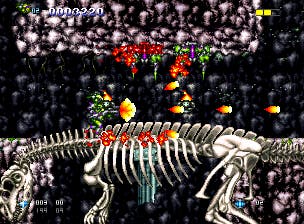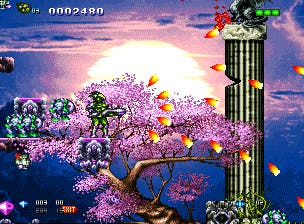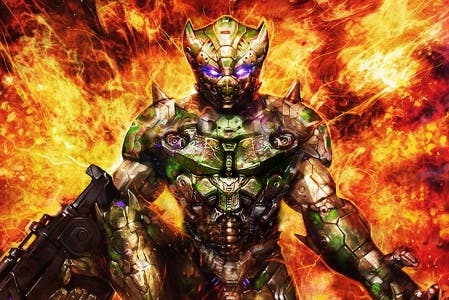Gunlord Review
To be this good takes AGES - Simon Parkin assesses this all-new Dreamcast game.
'Jump. Shoot. Explore.' Gunlord's German developer has taken the old maxim that any video game can be boiled down to its verbs of play and subtitled this, its latest release for a defunct platform, with three that define the experience.
Most of the experience, at least. You could easily add 'rifle' (through the attic) and 'curse' (the lost SCART cable) to that list, as many players will spend the first half hour trying to piece together the necessary technological artefacts to get the game up and running on Sega's 14-year-old Dreamcast hardware.
But that's all part of the arcane experience - alongside copying down 15-character codes from the Game Over screen for entry into a remote website-driven leaderboard, or creating maps of the game's labyrinthine levels on graph paper.

It's been years since Sega turned off its Dreamcast servers (for one thing, nobody owns a 56k modem to access them any more) so Gunlord's approach to online multiplayer is unavoidably basic. But the game's old school approach runs deeper than those areas where it's born from necessity. This is a game that reaches back into the formative days of the video game medium not for inspiration that can then be subverted, as in mainstream indie hits like Braid and Fez, but for its very essence and vernacular.
It's in the garbled backstory, the tale of newlywed space captains Gordian and Vanessa Gaiden separated by a mysterious planet lord known as The Master. Gordian must defeat The Master if he his to ever see his new wife again, or enjoy a galaxy in which to spend their lives together. It has the promise of romance and the reality of mortal danger, themes still core to video games, but rarely written in such bold, back-of-an-exercise-book simplicity these days.
It's in The Master's minions: bats and beetles, flies and falcons, organic, recognisable shapes brought to life as steel robot clickers, each one seemingly plucked from a piece of Roger Dean's Psygonsis concept art. It's in the sprites, at once blocky and rich, which have a '90s awkward beauty that's somehow more authentic than the stylish 16-bit pastiche of so many current indie games. They may be heavy metal chic, all spikes and horns and fireballs, but they are nonetheless well drawn. It's in the game's nine stages, which boast unpretentious names like Techno Dungeon, Deadly Sewers and Electric Tower, each one as distinct and cohesive as a Metal Slug game, each one playing in much the same way that is labelled.

It's in the game design itself, built upon those three titular pillars - jump, shoot and explore - which introduces depth and complexity not through weapons that level up, or grand conceits based on the manipulation of time or space, but through a skilful arrangement of assets, pitch perfect interactions and layer after layer of secrets that draw you back. There are strands of Super Metroid's DNA here, not only in the Gunlord suit which cuts a Samus silhouette, but also in the ability to roll into a tight ball and whizz into vents and tight corridors. But there are greater echoes of Turrican in the taut gunplay - three basic weapons, unlimited in ammunition, with a few, more powerful and limited options to be found in the game's farthest reaches - and in the physics and platforming.
It's in the variety, which sees Gordian leap into his planet shuttle at the end of the sprawling first stage and taking to the air in a horizontal, Gradius shmup for the second, complete with a giant R-Typish alien seahorse end of level boss that conceals the weak spot on its stomach with a curled tail. It's in the Shinobi flutter of cherry blossom petals in the third stage, the Sonic pools of acid in the seventh and the Gunstar Heroes sunset reds in the seventh. Gunlord presents a rich tapestry woven from design threads plucked from across the medium's most popular 2D years.
Nevertheless, the game asserts its own identity at every turn. Each level is filled with pink jewels - two hundred or so small ones and a dozen-odd giant ones. These collectibles, alongside precious heath refills and extra lives, inspire exploration off the beaten track. Designer Rene Hellwig often uses them to highlight seemingly unreachable areas, the implication of a riddle.

Meanwhile, as well as your ranged weapon, your armory contains a powerful beam weapon that arcs around as if sprayed from a firehose. It's powered by a gauge that empties with use and refills with rest, and switching between this short-range attack and your choice of long-range shots is key to felling many enemies within the game, especially the hulking bosses.
Outside of combat this is a mostly balanced platformer, which matches its spikes, pitfalls and scalable walls with wide, open space that allow for a breezy pace. You have three notches of health for each 'life', one of which is lost every time you swallow a bullet or touch a spike. Health pick-ups are few and far between, and as a result the learning curve is steep and setbacks frequent. Your score is reset every time a continue is used and, mercifully, continues are limited to remove the temptation for players to play through without learning the necessary skills to warrant such progress.
While the game's playable with the standard Dreamcast controller, it's best played with an arcade stick, where the binary inputs return crisp and precise from the 60 frames per second graphics. There's the odd hiccup - an asset that fails to load in for a split second, or a momentary pause while the spinning disc catches up with the screen. Likewise, the collision detection can, at times, feel off. But these are minor glitches in a game style that has not been seen so lively and excitable since Super Turrican.
'Retro' is a clumsy, unwelcome word when applied to an artistic medium. After all, we don't speak of retro music or retro cinema, even when referring to those songs and films created with long out-dated technology. Gunlord is retro in the sense that it feels like a game designed 15 years ago. It's not looking to subvert or build upon anything that has gone before, so much as simply sidle up alongside those old greats and take its seat at the table. A yearning experience, then, but one whose quality does not rest upon nostalgia alone.

